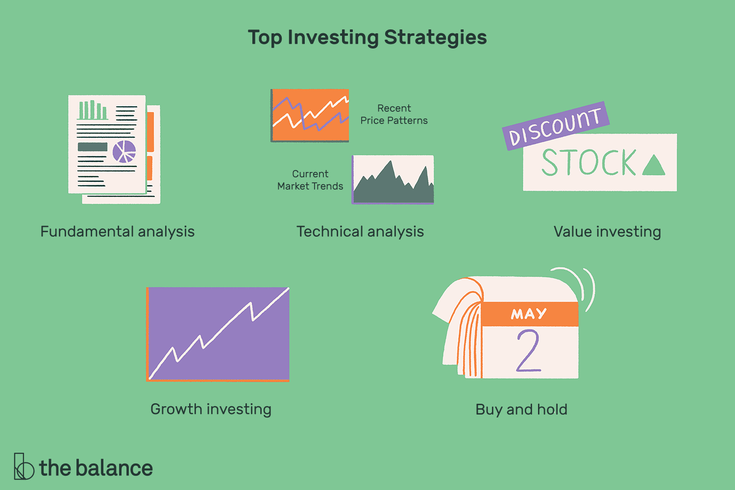The Best Investment Strategies
Which of These Top Investing Strategies and Styles is Best for You?
The best investing strategies are not always the ones that have the greatest historical returns. The best strategies are those that work best for the individual investor's objectives and risk tolerance. In different words, investing strategies are like food diets: The best strategy is the one that works best for you.
Also, you don't want to implement an investment strategy and find that you want to abandon it for some hot new trend you discovered online. Don't get confused by all of the too-good-to-be-true flavors of the month. Stick to the time-tested basics.
To use another familiar metaphor, investing styles and tactics are like the clothes that fit you best. You don't need anything expensive or tailor-made; you need something comfortable that will last a long time, especially if your investment objective is long-term (10 years or more).
So before making a commitment to anything, whether it be food diets, clothes, or investment strategies, see which works best for your personality and style. You can start by considering the top five investing strategies which are shown below, some of which are theories, styles or tactics, which can help you build a portfolio of mutual funds or ETFs.
Best Investing Strategies: Growth Investing
We begin with growth investing using fundamental analysis because it is one of the oldest and most basic forms of investing styles. Growth Investing is an active investing strategy that involves analyzing financial statements and fundamental factors about the company behind the stock.The idea is to identify a company whose business metrics shows evidence of the potential to grow substantially in the years ahead. This style of investing looks to construct a portfolio of 10 or more individual stocks, rather than selecting an index fund.
It can be considerably time-intensive for a beginner to do enough quality research to be successful at this investing strategy; however, this strategy, or a variation of it, is the bread-and-butter work that most professional fund managers do to generate returns in their line of work.
Growth stocks typically perform best in the mature stages of a market cycle when the economy is growing at a healthy rate. The growth strategy reflects what corporations, consumers, and investors are all doing simultaneously in healthy economies--gaining increasingly higher expectations of future growth and spending more money to do it. Again, technology companies are good examples here. They are typically valued high but can continue to grow beyond those valuations when the environment is right.
Data from the financial statements is used to compare with past and present data of the particular business or with other businesses within the industry. By analyzing the data, the investor may arrive at a reasonable valuation (price) of the particular company's stock and determine if the stock is a good purchase or not.
Best Investing Strategies: Active Trading
Active Trading is very difficult. Less than five percent of those who attempt it have any reasonable measure of success at it, and less than 1 percentage of traders manage to have stellar returns, but those who do manage to achieve such returns can make a tremendous amount of money. The tool most frequently applied in active trading is some form of technical analysis. This research tool focuses on the changes in price of the stock, rather than in the measurements associated with the underlying business. As such, traders can profit from much shorter-term moves and have the opportunity to employ leverage with their strategies.
Traders can work on any time frame from months, to days to minutes or even seconds. They often use price data from exchange feeds or from charting platforms to recognize recent price patterns and correlated market trends. They use these in an attempt to predict future price movements. Since no indication is infallible, a trader must establish parameters for acceptable levels of risk, reward and win-loss rates for their trading. While technical analysis may be the primary tool for active traders, and fundamental analysis may be the primary tool for growth investors, proponents of both camps make use of both tools on frequent occasions.
A slower-paced version of active trading that is more acceptable to professional money mangers may be employed in specialty funds and by individual investors as well. This strategy is known as momentum investing. The strategy acknowledges that even in random price movement trends manifest themselves and are capable of being capitalized. Longer term investments intended to last several months may be initiated with the expectation that momentum will continue to build and price will continue in the same direction. Most commonly, and especially with mutual funds designed to capture the momentum investing strategy, the idea is to "buy high and sell higher." For example, a mutual fund manager may seek growth stocks that have shown trends for consistent appreciation in price with the expectation that the rising price trends will continue.
Best Investing Strategies: Value Investing
Mutual fund and ETF investors can employ the fundamental investment strategy or style by using value stock mutual funds. In simple terms, the value investor is looking for stocks selling at a "discount;" they want to find a bargain. Rather than spending the time to search for value stocks and analyze company financial statements, a mutual fund investor can buy index funds, exchange-traded funds (ETFs), or actively-managed funds that hold value stocks. However, these securities still have similar market and liquidity risks as value stocks have, so due diligence is still required.
Best Investing Strategies: Buy and Hold
Buy and hold investors believe "time in the market" is a more prudent investment style than "timing the market." The strategy is applied by buying investment securities and holding them for long periods of time because the investor believes that long-term returns can be reasonable despite the volatility characteristic of short-term periods. This strategy is in opposition to absolute market timing, which typically has an investor buying and selling over shorter periods with the intention of buying at low prices and selling at high prices.
The buy-and-hold investor will argue that holding for longer periods requires less frequent trading than other strategies. Therefore trading costs are minimized, which will increase the overall net return of the investment portfolio.
Portfolios employing the buy and hold strategy have been called lazy portfolios because of their low-maintenance, passive nature.
1. Core and Satellite: Core and Satellite is a common and time-tested investment portfolio design that consists of a "core," such as a large-cap stock index mutual fund, which represents the largest portion of the portfolio, and other types of funds—the "satellite" funds—each consisting of smaller portions of the portfolio to create the whole. The primary objective of this portfolio design is to reduce risk through diversification (putting your eggs in different baskets) while outperforming (obtaining higher returns than) a standard benchmark for performance, such as the S and P 500 Index. In summary, a Core and Satellite portfolio will hopefully achieve above-average returns with below-average risk for the investor.
2. The Dave Ramsey Portfolio: Popular talk show host and generally respected personal finance guru Dave Ramsey has long-supported his four mutual fund portfolio strategy for his listeners and fans. Dave's wisdom is in his simplicity; his delivery and financial methods are easy to understand. However, the wisdom stops there. These four mutual fund types will often find fund overlap, which means there is little diversity. Furthermore, lower-risk assets, such as bonds and cash, are completely absent from the portfolio.
3. Modern Portfolio Theory: Modern Portfolio Theory (MPT) is an investing method where the investor attempts to take a minimal level of market risk to capture maximum-level returns for a given portfolio of investments. An investor that follows the tenets of MPT may use a core and satellite approach, as described in number 1 above. At the core of investment philosophy, every investor would like to achieve the highest possible return without taking extreme levels of risk. But how can this be done? The short answer is diversification. According to MPT, an investor can hold a particular asset type, mutual fund, or security that is high in risk individually but, when combined with several other asset types or investments, the whole portfolio can be balanced in such a way that its risk is lower than some of the underlying assets or investments.
4. Post-Modern Portfolio Theory (PMPT): The difference between PMPT and MPT is the way they define risk and build portfolios based upon this risk. MPT sees risk as symmetrical; the portfolio construction is comprised of several diverse investments with various risk levels that combine to achieve a reasonable return. It is more a big picture view of risk and returns. A PMPT investor sees risk as asymmetrical; the way investors feel about losses is not the exact opposite mirror image of how they feel about gains, and each economic and market environment is unique and evolving. PMPT sees that investors do not always act rationally. Therefore PMPT accounts for the behavioral aspects of the investor herd, not just the mathematical model that MPT follows.
4. Tactical Asset Allocation: Tactical asset allocation is a combination of many of the previous styles mentioned here. It is an investment style where the three primary asset classes (stocks, bonds, and cash) are actively balanced and adjusted by the investor with the intention of maximizing portfolio returns and minimizing risk compared to a benchmark, such as an index. This investing style differs from those of technical analysis and fundamental analysis in that it focuses primarily on asset allocation and secondarily on investment selection. This big-picture view is for a good reason, at least from the perspective of the investor choosing tactical asset allocation.
To repeat the first point of this article. Choosing an investment strategy or style is no different than choosing investments: Each investor is unique and the best strategy is the one that works best for their unique investment objectives and tolerance for risk.
This article originally appeared here.





